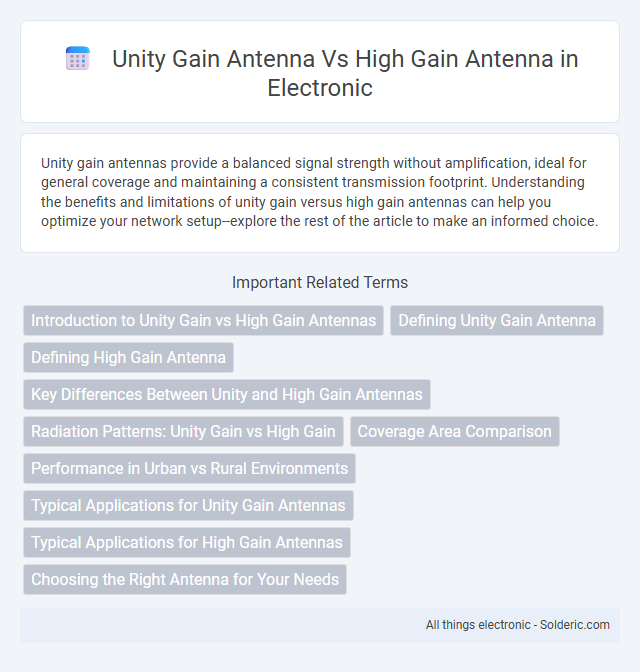Unity gain antennas provide a balanced signal strength without amplification, ideal for general coverage and maintaining a consistent transmission footprint. Understanding the benefits and limitations of unity gain versus high gain antennas can help you optimize your network setup--explore the rest of the article to make an informed choice.
Comparison Table
| Feature | Unity Gain Antenna | High Gain Antenna |
|---|---|---|
| Gain (dBi) | 0 dBi (Reference level) | Above 6 dBi (Typically 6-15 dBi) |
| Radiation Pattern | Omnidirectional | Directional or Semi-directional |
| Range | Short to moderate coverage | Extended coverage and longer distance |
| Application | General use, broad coverage areas | Point-to-point links, long-range communication |
| Size & Design | Compact and simple | Larger, more complex structure |
| Signal Strength | Standard signal power output | Amplified signal strength, higher SNR |
Introduction to Unity Gain vs High Gain Antennas
Unity gain antennas provide a baseline signal amplification level of 0 dBi, offering omnidirectional coverage suitable for close-range communication environments. High gain antennas, measured in dBi values significantly above 0, focus energy in specific directions to extend signal range and improve link quality over longer distances. The choice between unity gain and high gain antennas depends on the balance between coverage area and signal strength required for the wireless application.
Defining Unity Gain Antenna
A unity gain antenna is designed to radiate radio frequency energy uniformly in all directions, providing a gain of 1 (0 dBi), meaning it neither amplifies nor attenuates the signal compared to an isotropic radiator. Unlike high gain antennas, which concentrate energy in specific directions to extend range and improve signal strength, unity gain antennas offer consistent coverage ideal for your applications requiring even signal distribution. Understanding the distinction helps optimize antenna selection based on coverage area and signal quality needs.
Defining High Gain Antenna
A high gain antenna concentrates radio frequency energy into a narrower beam, significantly increasing signal strength and range compared to unity gain antennas, which radiate energy uniformly in all directions with a gain of 0 dBi. High gain antennas achieve gains of 8 dBi or more, making them ideal for long-distance communication and applications requiring focused signal transmission. The increased directivity reduces interference and enhances signal quality, crucial in wireless networks, radar, and satellite communication systems.
Key Differences Between Unity and High Gain Antennas
Unity gain antennas offer a balanced, omnidirectional signal strength ideal for short-range or general coverage, while high gain antennas focus the signal into a narrow beam for extended range and improved performance in specific directions. The key differences lie in their radiation patterns, with unity gain providing a wide, consistent coverage area and high gain delivering stronger signals over longer distances. Your choice depends on whether you prioritize broad coverage or targeted signal strength for enhanced communication efficiency.
Radiation Patterns: Unity Gain vs High Gain
Unity gain antennas exhibit nearly spherical or omnidirectional radiation patterns, providing uniform signal coverage across a broad area, ideal for general-purpose communication. High gain antennas concentrate energy into narrower, more focused beams, achieving greater range and signal strength but with reduced coverage angles. Your choice between unity gain and high gain antennas depends on the desired balance between coverage area and signal reach.
Coverage Area Comparison
Unity gain antennas provide a more uniform coverage area, radiating signals equally in all directions, making them ideal for general-purpose applications and environments requiring consistent signal distribution. High gain antennas concentrate the signal energy in a specific direction, significantly increasing the effective range and signal strength within that focused area while reducing coverage in others. This directional focus results in a narrower coverage beam, enhancing performance for long-distance communication but limiting overall spatial coverage compared to unity gain antennas.
Performance in Urban vs Rural Environments
Unity gain antennas provide consistent, omnidirectional coverage ideal for urban environments with multiple signal reflections and obstructions. High gain antennas focus energy in a specific direction, enhancing signal range and strength in rural areas with fewer obstacles and longer distances. Your choice depends on whether you need broad coverage in cluttered spaces or extended reach in open landscapes.
Typical Applications for Unity Gain Antennas
Unity gain antennas are commonly used in applications where omnidirectional coverage and minimal signal amplification are required, such as Wi-Fi routers, Bluetooth devices, and basic radio communications. These antennas are ideal for environments that demand consistent signal strength without focusing the transmission or reception in a specific direction, enabling reliable connectivity in residential and small office settings. Their balanced radiation pattern supports stable performance in crowded wireless environments and short-range communication systems.
Typical Applications for High Gain Antennas
High gain antennas are typically used in long-range communication systems, such as satellite links, radar systems, and point-to-point wireless networks, where focused signal strength is crucial. They provide increased directivity and range compared to unity gain antennas, making them ideal for overcoming obstacles and minimizing interference in complex environments. Your choice of a high gain antenna enhances signal quality and reliability in applications requiring precise, distant signal transmission.
Choosing the Right Antenna for Your Needs
Unity gain antennas provide an omnidirectional radiation pattern ideal for short to medium-range communication with minimal signal distortion, making them suitable for general use and areas where consistent coverage is needed. High gain antennas concentrate energy in specific directions to extend range and improve signal strength, which benefits applications requiring long-distance communication or enhanced signal quality in targeted zones. Your choice should depend on coverage requirements and environment, with unity gain best for broad coverage and high gain optimal for focused, long-range connectivity.
unity gain antenna vs high gain antenna Infographic

 solderic.com
solderic.com